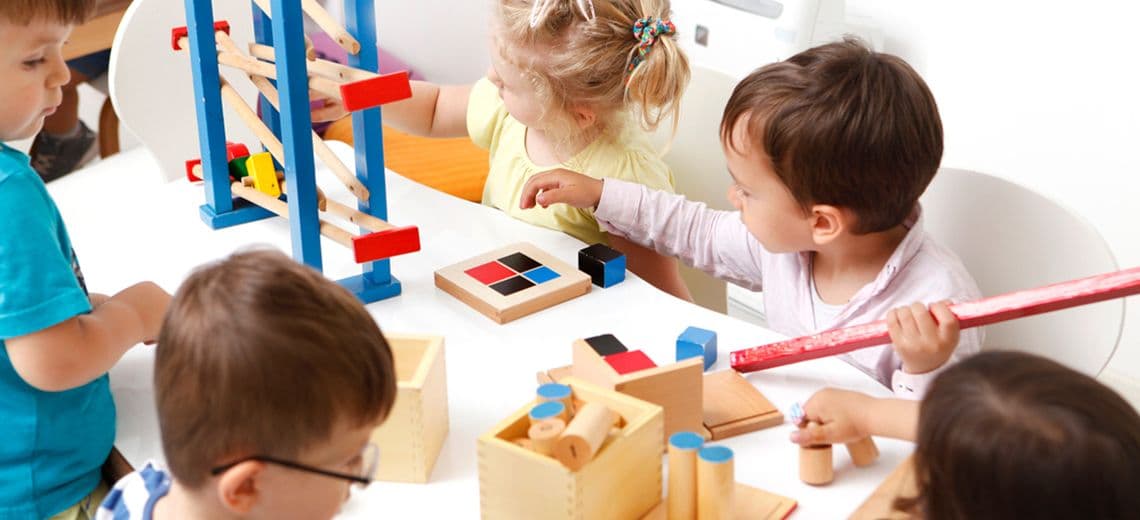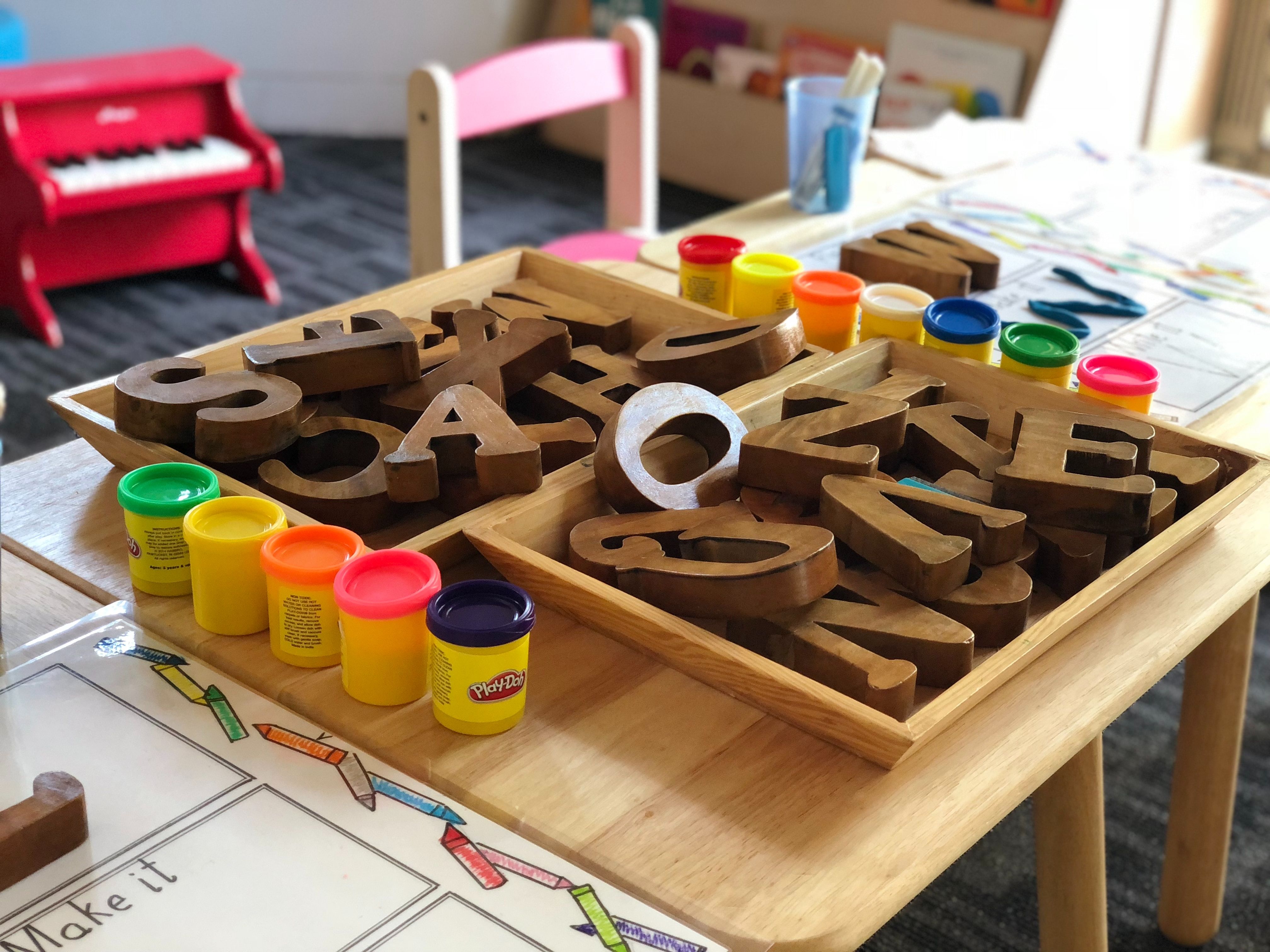
The Benefits of Play-Based Learning
Play-based learning is a way to make learning engaging, fun, and creative for your little learner!

What is Play-Based Learning?
Play-Based Learning is an open-ended, child-led, teacher-supported form of early childhood education. In sum: it’s playing for the sake of play, but engages the child’s imagination and develops their innate interest in learning. With adult engagement, however, the ‘learning’ for young children comes in the form of guided vocabulary words and techniques that become the bedrock of associative learning. It can look like many things: playing with sensory bins, stacking blocks, or dramatic play with costumes and props.
As a parent, you may be concerned that unstructured, open-ended play won’t adequately prepare your toddler for kindergarten. Yet, there are many educational benefits to this kind of learning: children will develop social and motor skills, language, and pre-mathematical skills as they explain their thoughts and count their way through the play, as well as self-regulation and impulse control-- needing to clean up your mess is a great motivator to be neater!
Play-Based Learning is very different from its more traditional counterpart, Academic Learning. Academic Learning is teacher-centric and emphasizes a “correct” answer as well as retention of concepts, facts, and ideas. While this traditional way of teaching offers benefits such as familiarity with letters, numbers, shapes, and colors, it results in more behavioral issues in young children if they aren’t also getting plenty of play-time. Young children actually often lose interest in this type of learning because their own creative imagination isn’t engaged as much, and they are told what to learn and focus on. In fact, research has shown that earlier introduction to Academic Learning does not speed up a child’s cognitive development.
Play-Based Learning Activities
Luckily, it’s easy to create a play-based learning classroom in your home! Creating “stations” for different activities that your children or students can choose among, with parent or teacher support, playing at each station for as long as they like before moving onto the next one.
Sensory Bins
Fill a plastic bin about a quarter of the way full with water or dry beans or rice. Place different colorful objects inside, such as pom-poms (note: make sure objects are large enough that they won’t be a choking hazard!). The sensations of the beans or rice and discovering objects in water is a lot of fun for 2 and 3-year-olds! Pairing this with descriptions about texture, color and shape will also boost your child’s vocabulary and ability to identify these different sensory experiences. If you have a garden or can get to a beach, playing in sand and dirt has the same benefits as a sensory bin, plus the immeasurable benefits of being in nature.

Playdough
Molding soft, colorful playdough is a perfect play experience for toddlers. The experience of seeing their movements sculpt and change the shape of the playdough lays the groundwork for a lifetime of creative expression and learning.
If you want to enhance this activity, you can easily make your own homemade playdough with your kids. This offers them the academic experience of measuring, counting and combining different ingredients, followed by the reward of playing with what they have made! Kids love to mix the ingredients together and participate in activities that adults usually do.
Here is an easy homemade playdough recipe:
- 1 cup of flour
- 1/4 cup of salt
- 3/4 cup of water
- 1 tablespoon of vegetable oil
- Food coloring
- You can also add glitter!
Costume Boxes
A good costume box is easy to make! You can find different pieces at a thrift store, use old clothing that would otherwise be given away, and even add scraps of fabric and materials like ribbons. Costume jewelry and props, such as toy swords are a great way to add more elements for creativity. Giving kids all the time they want to dig through the box and check out all the costume pieces encourages them to go out and discover. Allowing children to wear costumes however they choose (even if it’s not ‘the right way!’) helps them practice ‘flexible thinking’: the ability to shift thinking, attention, and responses based on new circumstances. Since there’s no right answer to how to play with costumes, the possibilities are endless! Costume play generally leads to dramatic play, like creating silly characters, or playing a favorite character from a movie or TV show!

Advantages of Play-Based Learning
Research from many organizations, including The Institute of Education Sciences and The Hechinger Report shows that there is much to be gained from a play-based early education program.
- Play-based learning greatly supports motor skill and social-emotional development.
- It also supports language development, literacy, and improved outcomes in mathematical education.
- It is linked to skills in collaboration, creativity, critical thinking, and confidence.
- Play-based learning is most appropriate to the stages of brain development occurring during early childhood.
- It is so effective that, among children ages 3-6, it can close achievement gaps when employed as an intervention method.
Advice to Parents
While it is tempting to invent an imaginary “scenario” or guide children to specific academic outcomes, try to keep this kind of engagement to a minimum and instead look for cues from the children. Are they focused on scooping beans or rice into piles? Present toys, like a toy bucket or scoop, that help them to do this. Are they calling the playdough “pizza”? Make playdough pizzas with them, or find an object to help them roll the dough. Let them show you what calls their attention and support them in deepening their own curiosity and ideas.
The simple experience of being a kid is endlessly educational. Play-Based Learning offers children a positive relationship to learning in which they participate, engage, and learn that their ideas and observations have value. Naturally, teachers and parents want those educational experiences to create lasting positive impressions to carry their kids throughout their lives, but it’s important to remember that play opens young minds to the possibilities of learning as an adventure!

